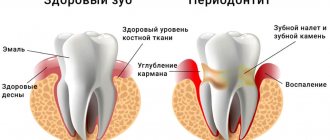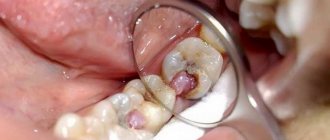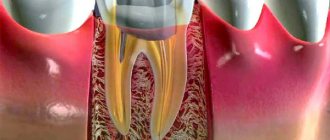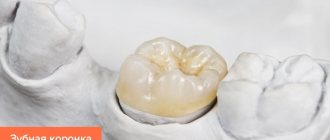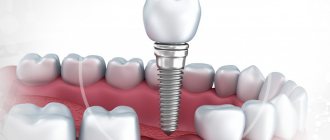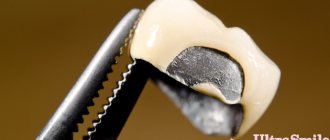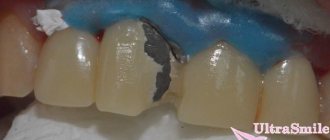How is dental filling performed?
Installing a filling is a standard procedure that takes place under local anesthesia. First, the person is given an injection in the gum to numb the problem area. After this, doctors proceed to treat the incisor, and the process lasts on average 15-20 minutes.
Main stages:
- The doctor prepares the enamel and drills out the softened dentin using a drill. The patient does not feel pain because he was given an injection.
- The oral cavity is disinfected using an antiseptic solution.
- A special paste with a healing effect is installed, and a gasket is placed for insulation.
- The walls of the oral cavity are dried using air flow.
- The mass is applied layer by layer for further filling.
- The filling is polished to obtain the required occlusion. The crowns should fit tightly.
- Fluoride varnish is applied for protection and distributed over the surface of the filling.
The procedure is simple and standard, so dentists perform it quickly. The patient only needs to listen to the doctor’s advice to avoid problems. If the filling is installed efficiently, it will last for more than one year. The specific period depends on the selected material, quality, and food preferences of the person. Filling is one of the most effective methods of combating caries and pulpitis. Moreover, the procedure is inexpensive and has a minimum number of contraindications.
Stages and technology
Today, they no longer remove a diseased tooth, but treat it. In case of caries, the doctor fills it. The service life of such a tooth will directly depend on the professionalism of the specialist and the quality of the material used.
Pain may occur during the procedure because the pulp contains nerve endings that immediately send a signal to the brain. But today there are many anesthetics that make the patient feel no pain.
If we talk about filling technology, it is divided into several stages:
- Initially, an anesthetic injection is given to relieve pain;
- carefully process, clean the area of the tooth that has been damaged by caries. If the pulp is inflamed, it is removed, after which the cavity is disinfected. If there are small areas of affected tissue under the filling, the inflammatory process will begin again;
- In case of minor damage to the teeth, a medical lining is placed. If the process is started, then the pins are installed;
- the material is selected, it all depends on several factors;
- An x-ray is taken to look at the result and make sure that the affected areas have been completely removed;
- The composite is sanded, and the filling is then coated with indelible varnish.
Filling dental canals
Canal treatment is carried out during deep treatment. The pulp that fills the tooth area is removed, and the walls are cleaned and ground. The process may take a long time, and then the person will have to visit the doctor several times. You will have to install a temporary filling.
The problem area is treated with antibacterial compounds, after which a filling mass is applied. If the procedure is carried out efficiently, then the x-ray will show that the cavity is 100% filled.
The main methods of canal therapy:
- Application of gutta-percha. A standard treatment method that allows you to fill the canals. Hot and cold options are available.
- Depophoresis. The area of the tooth when there are cracks and curvatures is effectively sterilized. The drug is used using a special tool. It can penetrate even into distant areas of the channel.
- Mummification. Impact doses of antiseptic are introduced into the pulp area. The advantage of this option is that the likelihood of inflammation disappears.
- Retrograde filling. A gun with a special attachment is used for it. With its help, you can completely fill the problem cavity.
The dentist will independently choose the appropriate option depending on the situation. The decision is made after an examination, since it is important to determine the condition of the tooth and canal.
Is it possible to restore a tooth again?
Today, there are frequent calls from patients whose teeth are destroyed, treated 7-10 or more years ago. Back then, old technologies were used, the materials had expired, and the tooth needed to be restored again.
Many people just want to grind down the tooth and put a crown on it. During the consultation, we consider all methods. If the tooth has been filled and there is a chip in the filling or wall, then by eliminating the defect, this is possible. But, when complex restoration has already been carried out, especially on the frontal units, canines, replacement of old structures is necessary.
If the tooth was strengthened with a metal pin, and the wall was built up with a composite material, which darkened over time and began to crack, then drastic intervention will be required. First, you need to free the tooth from used materials: remove the filling, remove the pin. If necessary, treat incipient caries (often the patient himself does not know about the developing process).
The best way out
– this is the installation of inlays or solid modules, crown plus tooth root, using Cerec.
The scanner will “notice” all the structural features of the tooth; the program takes into account not only the features of the unit, but also all the nuances of the bite. How long does it take to make such crowns or complete modules for teeth? Only 1.5 hours
, small temporary deviations are possible.
The new tooth will look natural. During the consultation, we will decide how to restore the unit, what kind of crown is needed for the tooth, and choose the technology. At my appointment, you will feel calm, absolutely not afraid. Believe me, I will find a way to save a tooth even in the most difficult cases.
Types of fillings
Conventionally, fillings are divided into temporary and permanent. They differ in characteristics and purpose. Temporary ones are placed for therapeutic and diagnostic purposes. Often the composition of the material contains medicinal additives that are necessary for the treatment of a specific disease. The filling will last a short period of time - from 7 days to a month. Much depends on the situation, but in any case you will have to contact a medical specialist again soon.
The integrity of a temporary filling cannot be maintained for more than two weeks. For this reason, you should not put off visiting the dentist until later if you want to avoid problems.
The temporary variety is used in certain situations. A noticeable carious lesion may be observed, but it may not be clear whether only the enamel is affected or whether the lesion has reached the pulp. The doctor will want to examine the incisor in more detail to make an accurate conclusion and perform the correct treatment. The dentist will perform a temporary filling and then monitor the person. If the pain persists, then pulpitis can be suspected. In such a situation, you will have to remove the neurovascular bundle, perform root canal therapy and fill the cavity.
There are several types of permanent fillings. This type is generally intended for long-term and reliable sealing of the treated tooth. It is important to preserve the original characteristics of the incisor, that is, the chewing function should not be impaired. If the tooth is in the anterior region, then it is important to preserve the natural color and shape. In this case, it will not be noticeable that the person did the filling.
Types of fillings depending on the material:
- Cement. It is durable, lasts a long time and meets all requirements. It is important to understand that the density of a cement filling is higher than that of enamel. For this reason, the area that surrounds the filling gradually wears out. As a result, the marginal zone becomes vulnerable, which can lead to secondary caries.
- Amalgam. This variety has many disadvantages. For this reason, this option is extremely rarely used. The composition contains mercury, zinc, copper and silver. The material is durable and does not wear out for a long time. Disadvantages include toxic effects, poor aesthetics and low levels of adhesion.
- Plastic. Now this option is not used, since the material is toxic, has a high probability of deformation, and is easily washed and stained. There is a significant chance of encountering a complication - a secondary form of caries.
- Ceramics. The material is expensive, but of high quality. The filling can last from 20 to 25 years. Ceramics are excellent for filling; their appearance is close to natural teeth. It is durable, resistant to temperature fluctuations, and retains its original shade. Expensive, but the highest quality material.
- Light polymer. The material is considered in demand because it is inexpensive, resembles real teeth in appearance, and has optimal technical performance. The light filling hardens under the influence of an ultraviolet lamp. The dentist may spend a long time shaping the tooth until it achieves the desired appearance. Average service life is 5 years. During this period, the aesthetic appearance is maintained.
- Composite It contains porcelain, which makes the fillings durable and hard. The service life reaches 10-15 years. Among the disadvantages, polymerization shrinkage can be noted. It can be prevented by using additional adhesives that will prevent the occurrence of secondary caries.
It is difficult to say unequivocally which material is best suited in a particular situation. It all depends on the person’s personal wishes, financial capabilities and tooth condition. It is recommended to choose only high-quality materials that will last a long time.
Why does caries develop under the filling mass?
The development of a carious process under the filling material is often observed due to poor-quality treatment of the tooth cavity during treatment. The remains of the affected tissues serve as a source of infection, which intensifies and covers increasingly larger areas of the dentition unit.
Caries can also form if the filling is carried out in violation of the protocol. An incorrectly applied composition quickly becomes unusable, losing its fixation with the walls of the tooth cavity or collapsing under the influence of the aggressive environment of the oral cavity. Microbes penetrate into the resulting cracks and voids, which “trigger” the destructive process.
Another factor that provokes the development of caries is the natural “aging” of the filling. The appearance of microdamages (and micropores) on it and in it, which is inevitable over time, contributes to the accumulation of pathogenic bacteria, their reproduction, and the occurrence of recurrent disease. Therefore, it is advisable to replace old fillings with new ones after their expiration date.
Filling teeth without pain
Nowadays people do not need to be afraid of visiting the dentist, because dental treatment is carried out without pain. High-quality anesthesia is used, and an allergy test is performed first. If the body accepts the drug normally, then the dose is administered in the gum area. After 1-2 minutes the effect appears. A person may notice that the problem area has lost sensation. After this, the doctor can proceed to the procedure itself.
When using anesthesia, a person will not feel pain. You will be able to relax in the dental chair and not worry about anything. This treatment option is the most preferable, because not every patient wants to endure pain.
Some people decide not to use anesthesia. This is because they do not want to administer the medicine or are suffering from an allergic reaction. If the nerve is not affected, the procedure will cause virtually no pain. An experienced specialist will do everything to make the patient feel as comfortable as possible.
How to extend the service life of filling material
How often the filling will have to be changed depends on how correctly it is used. To extend the life of the material, just listen to the following tips:
- don’t skimp on material: very cheap means it won’t last long,
- avoid increased stress on the filling: do not open bottles, avoid excessively hard foods,
- avoid sudden changes in temperature in the oral cavity: do not take too hot or cold food,
- select oral hygiene items and products in accordance with the characteristics of the teeth.
In addition, even in the absence of complaints, you need to regularly visit the dentist for timely detection of pathologies and defects. It is better to spend a few minutes grinding than to have to refill it after some time. Preventative visits will save time and money, and will also keep your nerves and teeth in perfect order.
How much should you not eat after filling a tooth?
Filling is considered a simple procedure, after which a person immediately returns to his normal lifestyle. At the same time, dentists warn that it is undesirable to eat and drink drinks right away. It is advisable to abstain from food for 2-3 hours. During this time, the filling will take root, so the food will not be harmful in the future.
It is recommended not to drink coffee or strong tea for 24 hours to avoid staining the material. If the procedure is carried out well, the person will not encounter any problems, and will therefore be able to fully chew with the repaired tooth.
Is a refilling necessary if nothing bothers me?
Many patients are surprised when a dentist recommends replacing an old filling with a new one, because they have no pain or other unpleasant symptoms. However, replacement is carried out not only in cases of severe inflammation, but also for preventive purposes, as well as to improve the aesthetics of the dentition.
Like any other material, the filling mass is subject to gradual wear, deformation, and destruction. Hygienic care, oral microorganisms, saliva pH, mechanical, chemical and temperature effects of food over time provoke the appearance of microscopic cracks in the filling. The resulting pores serve as a breeding ground for microbes and the development of dental diseases.
Contraindications
In rare cases, filling leads to complications. A person experiences pain even after 3 days from the date of the intervention. Unpleasant sensations can be sharp and shooting, they cannot be eliminated with the help of analgesics. This happens when there is inflammation of adjacent tissues, incomplete removal of the nerve, or poor material. More often, complications are encountered by those people who did not take into account contraindications. In some cases, the procedure cannot be performed, as it can only worsen the situation.
Main contraindications:
- The tooth cannot be restored, so it will have to be removed.
- An x-ray revealed internal root resorption.
- There is severe resorption, which affects more than a third of the root.
- There are carious perforations in the bottom of the chamber.
- Bone loss in which there is loss of periodontal attachment.
- There is a follicular or odontogenic cyst.
The doctor will tell the person whether there are contraindications for the procedure.
When is a refilling required?
To determine when a filling needs to be replaced, you should contact your dentist. He will conduct a diagnosis, including x-rays, and, if necessary, carry out a replacement.
Indications for refilling are the following conditions:
- pain in a filled tooth,
- crown destruction,
- detection of caries under filling material,
- feeling of an unpleasant taste,
- decreased aesthetics of the restoration,
- expiration of the seal's service life.
The most common situations in which refilling is required are discussed below.
Changing Hue
Yellowness, darkening and other color changes in the filling (and enamel) most often indicate the presence of a destructive process in the tooth. If there is a reddish tint, it means that the previously installed material contains resorcinol - in this case, not only a refilling is required, but also additional cleaning of the canals, as well as an internal bleaching procedure.
Abrasion of the filling mass
Over time, the fillings wear out, which leads to disruption of the distribution of chewing load. As a result, the bite changes, the load on the temporomandibular joint increases, TMJ pathologies develop, and digestive problems arise.
Overhanging filling
If installed incorrectly, the filling material may “hang” over the adjacent tooth or gum. The accumulation of food particles and impaired contact between units of the dentition provoke an inflammatory process in soft tissues, the proliferation of microorganisms and the development of caries, and bleeding gums.
Subsidence of the filling mass
Shrinkage is typical for any materials used for filling. If it occurs along the axis of the tooth, a person’s bite may change, which will lead to problems with the TMJ and digestion. In addition, vertical subsidence provokes the appearance of cracks and even chips in the tooth, since, as the filling contracts, it “pulls” the hard tissues along with it. When subsidence occurs in the horizontal plane, the degree of contact between adjacent units changes, food debris gets stuck in the interdental spaces, the formation of caries and gum inflammation are observed.
Flat filling surface
If, when filling, the dentist did not pay due attention to the chewing surface, but made it flat, disruption of the chewing process will gradually lead to the development of problems with the gastrointestinal tract. Normally, there are cusps and fissures on it, which ensures full contact with the opposite teeth of the other jaw.
Roughness has appeared
The rough surface of the filling indicates the presence of pores and microscopic cracks in it. This means that microbes have already penetrated into it. Often, when the filling material is removed in such cases, caries is revealed underneath it.
Expired service life
Even if the filling was installed more than 10-15 years ago and still holds, it does not mean that it is fulfilling its function. In the vast majority of cases, when refilling such “rarities”, an extensive carious process is determined.
Unaesthetic appearance
Refilling may be required if the previously installed filling stands out in shade from the background of the remaining teeth. Most often, the situation occurs after the whitening procedure. Over the period of operation, old compounds have absorbed various coloring substances, so to restore the aesthetic appearance (especially of the front units), they need to be replaced.
Filling services in our clinic
Our clinic in the center of Moscow offers high-quality dental filling services. Experienced dentists with extensive experience approach each client individually and do everything to ensure that the procedure is comfortable. Doctors will choose the type of filling needed after examining the oral cavity. Only high-quality and modern materials are used, which have a long service life.
We perform root fillings without pain or any discomfort. If necessary, we will restore the primary incisors so that they do not further deteriorate and fall out prematurely.
Dentists guarantee a high-quality result - the filling will not differ in appearance from the tooth. It will last for a maximum period, which is determined by the selected material. There are both budget options and expensive ones. The client will be able to choose a specific filling service based on personal needs.
Indications
The cavity located inside the tooth, where the nerve endings and blood vessels are located, is called the pulp. If the caries lesion is not treated in a timely manner, the pathology reaches the pulp, which leads to the occurrence of an inflammatory process called pulpitis. The process does not go away on its own; the pain that inevitably arises is removed by painkillers in the initial stages. Over time, they also stop working. In advanced cases, inflammation spreads to the bone, which leads to periodontitis and, as a consequence, osteomyelitis. The main indication for root canal filling is pulpitis caused by caries.
Reasons for the development of childhood caries
Main risk factors:
- Excessive consumption of sweets. In this case, a harmful environment is formed in the child’s mouth, and the tooth enamel begins to suffer.
- Transmission of infection from relatives. This can happen when sharing utensils, adults licking a baby's spoon, and sometimes even kissing.
- Long contact with the bottle. This type of caries is called “bottle caries”. If a baby drinks a sweet liquid from a bottle and then falls asleep with it, then prolonged contact of the sweet with the teeth can lead to the rapid development of caries.
- Deficiency of fluoride and calcium in food.
- Lack of solid food. When chewing solid food, a lot of saliva is released, which naturally washes the oral cavity.
- The use of medications that change the composition of saliva.
- Chronic diseases.
- Improper care of baby teeth. Infants need to wipe their teeth from the moment they erupt - you can use ordinary gauze wrapped around your finger. It is very important for parents to teach older children to brush their teeth and use a brush, constantly remind them of this and monitor compliance with the procedures. The example of parents is a strong motivating factor here.
Dental treatment for children
The opinion of some parents that children’s baby teeth do not need treatment, since they will soon fall out anyway, is fundamentally wrong. A normal bite is formed on the basis of temporary teeth and, if caries progresses, the infection penetrates into the deep tissues and can damage the newly formed dentition.
Premature loss of baby teeth, destroyed by caries, leads to disorders that, even if they can be corrected, will cost a lot of time, money and nerves. The jaw develops with pathologies, permanent teeth grow out of place, often crowded. Subsequently, the child will have to wear braces for years in order to somehow straighten the teeth and achieve a normal smile.
Advanced caries causes pulpitis - inflammation of the dental nerve, periodontitis, and the formation of a cyst in the root area. To treat such consequences, you will have to fill the root canals. But the process does not stop there: periodontitis can turn into osteomyelitis and cause an abscess, and this is a problem on a completely different level. The disease reduces the overall immunity of the body and poses a threat to the very life of the child.
If you have any questions, doubts, etc., talk to your pediatric dentist, visit the clinic, sign up for a free consultation, find out how dental treatment for children is carried out, but do not leave your child alone with a problem he is not aware of. able to decide on my own.
How long does a temporary filling last?
Many patients are interested in how long can they walk with a temporary filling? Can it at least temporarily replace a permanent one, which costs more and requires another visit to the doctor?
Temporary tabs are different. This will determine how much it costs. The most short-lived ones isolate the oral cavity from arsenic, which is embedded in the pulp of the tooth. Typically, such treatment lasts for 2-3 days, and then it is necessary to change the temporary material to permanent one.
The service life of a temporary filling in the treatment of canals or periodontitis is slightly longer. You can use it for up to 2 months until inflammation and infection are completely eliminated. The doctor monitors the process using radiovisiography, a safe diagnostic method that has replaced x-rays in dental clinics.
A separate question is how many days a temporary filling is placed for prosthetics with massive non-removable structures? It all depends on the volume of work and timing, however, in most cases, temporary material will last the patient no more than a year.
If a patient has a temporary filling, how long after can he eat food so that it does not fall out? Usually you can eat it almost immediately, but it is worth remembering that temporary materials are very unreliable, so they can crumble and crumble under intense pressure on the tooth. This is normal and should not be a cause for concern.
Treatment tactics for mild forms of hypoplasia
When treating molars and premolars, continuous prevention is important, including remineralization therapy and fluoridation of partially erupted teeth. After complete eruption, the pits and fissures are sealed. In cases of enamel destruction or carious lesions, composite restorations are used, and, if necessary, ceramic crowns are placed in adolescents.
In the case of incisors and canines, the principles of prevention are similar. Brown-yellow defects in older children are bleached in a dental office with 10% carbamide peroxide.
